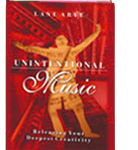UNINTENTIONAL MUSIC: RELEASING YOUR DEEPEST CREATIVITY
Why Is The Book Called Unintentional Music?
Whenever we play music or create, we intend to do it a certain way. Then something happens that we don’t intend. Mistakes, blocks, body problems that show up when we make music, and a host of other experiences that we don’t intend, are not just problems. If we follow them with curiosity and precision, they can lead us toward great music, profound experiences, personal transformation, and wellsprings of creativity.
This book focuses on music as a starting point, but includes all art forms and ways of expression. You may not consider yourself a musical person, but this book can help you find a wealth of creativity – a kind of creativity that goes way beyond music.
The unintentional appears at moments when some hidden part of us, something beyond out usual awareness, tries to express itself. If we start paying attention to what is trying to happen rather than what we think should happen, we open the door to self-expression and self-discovery beyond what we could have imagined.
Unintentional Music is rich with real-life stories, ideas, and practical techniques for unlocking creativity. Every chapter has an exercise you can try at home. Many people have told me that the book is passionate and poetic, filled with gripping examples. It is also clear, fun, and a pleasure to read, explaining complex concepts in a way that is understandable yet does not talk down to the reader.
The book is divided into the following parts:
Part One: Playing the Music Of Your Dreams
This part introduces the idea of unintentional music, clearly explains the philosophy and theory of Process Work and how this work with music is an outgrowth of Arny Mindell’s powerful methodology. We see also that our feelings and attitudes (metaskills) are vital to our ability to unfold unintentional music.
Part Two: Counterpoint
Here we see that unintentional music can lead us in the direction of self-discovery, and also in the direction of great music, deeper creativity, and more authentic expression.
Part Three: “Practice, Practice”
The title of this part comes from an old joke. “How do you get to Carnegie Hall?” We learn tools and methods for noticing, analyzing, and unfolding Unintentional Music. Some people who are less interested in working with others like to skim through or skip this part altogether. Others eat it up so they can use it with themselves and their clients.
Part Four: Variations on a Theme
Here we see how these ideas can transform music lessons. There’s also a chapter on “The Hated Voice.” When writing this book, I wasn’t brave enough to say what this chapter is really about. All the stories in this chapter are about expression, and what stops us from expressing ourselves. Even more, these stories are about oppression and marginalization, and how working with unintentional music can help us combat oppression on the outside and within us. Please read it with this lens. (I guess if I had taken this to heart, I wouldn’t have stopped myself from expressing what I really wanted to say. We teach what we need to learn.)
Part Five: Living Creativity
This is the most personal part of the book. It starts off giving examples of how this work can be used with all kinds of creativity. There’s an exciting and useful chapter on working with creative blocks, where I use my own experiences as examples. I realized while editing the book that so much of my focus was on the unintentional, and that for me intention itself was unintentional. So I added a chapter on the importance of intention, describing four kinds of creative intent. The next chapter talks about the ultimate creative block. It details how my mother’s life threatening illness stopped her from doing her life work (sculpting stone and wood), and how our work on her cancer and her nighttime dreams ultimately transformed her creativity in beautiful and moving ways. The last chapter is a rhapsody in which I walk my talk and let disturbances transform my writing into a passionate and poetic plea to the reader.
You can buy the book here.
You can read the Introduction here.
This website also has a “chapter of the month,” so feel free to come back each month and, in time, read the whole book. Or just experience the chapter that’s featured this month. Don’t forget that each chapter has an exercise that you can try on your own. Enjoy!

